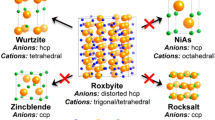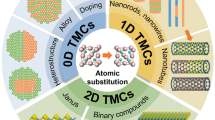Abstract
Noble metal chalcogenides (NMCs) are an important class of materials with unique properties and widespread applications; however, the synthesis of these materials in a well-controlled manner remains challenging. Cation exchange (CE) transformation is a versatile, topotactic strategy which enables the synthesis of a range of materials, but its use for preparing NMCs has not been studied in detail, impeding the application of these materials. Here we demonstrate a robust and general strategy for the fabrication of a wide variety of NMCs via CE transformations, in which CuTe metal chalcogenides are used as sacrificial templates for CE with noble metal cations. The generality of the CE strategy is validated by the fabrication of NMCs with tailored morphologies (zero-dimension (0D), 1D, 2D and 3D), compositions (Pd/Pt/Rh/Ru/Ag/Au-based NMCs) and phases. In-depth mechanistic study shows that the well-controlled synthesis of NMCs is realized by kinetic control and solvent-dependent thermodynamic control.






Similar content being viewed by others
Data availability
The additional characterization data, experimental data, and theoretical calculation data are provided in the Supplementary Information. Source data are provided with this paper.
Code availability
The computational codes used in this work are available from the commercial Vienna Ab initio Package and Accelrys Materials Studio.
References
Wang, Y., Li, Y. & Heine, T. PtTe monolayer: two-dimensional electrocatalyst with high basal plane activity toward oxygen reduction reaction. J. Am. Chem. Soc. 140, 12732–12735 (2018).
Lin, X. et al. Intrinsically patterned two-dimensional materials for selective adsorption of molecules and nanoclusters. Nat. Mater. 16, 717–721 (2017).
Zhao, Y. et al. High-electron-mobility and air-stable 2D layered PtSe2 FETs. Adv. Mater. 29, 1604230 (2017).
Zhou, J. et al. A library of atomically thin metal chalcogenides. Nature 556, 355–359 (2018).
Ciarrocchi, A., Avsar, A., Ovchinnikov, D. & Kis, A. Thickness-modulated metal-to-semiconductor transformation in a transition metal dichalcogenide. Nat. Commun. 9, 919 (2018).
Chow, W. L. et al. High mobility 2D palladium diselenide field-effect transistors with tunable ambipolar characteristics. Adv. Mater. 29, 1602969 (2017).
Fu, L. et al. Highly organized epitaxy of Dirac semimetallic PtTe2 crystals with extrahigh conductivity and visible surface plasmons at edges. ACS Nano 12, 9405–9411 (2018).
Pi, L. et al. Recent progress on 2D noble-transition-metal dichalcogenides. Adv. Funct. Mater. 29, 1904932 (2019).
Yim, C. et al. Wide spectral photoresponse of layered platinum diselenide-based photodiodes. Nano Lett. 18, 1794–1800 (2018).
Ugeda, M. M. et al. Giant bandgap renormalization and excitonic effects in a monolayer transition metal dichalcogenide semiconductor. Nat. Mater. 13, 1091–1095 (2014).
Zhang, Y. et al. Direct observation of the transition from indirect to direct bandgap in atomically thin epitaxial MoSe2. Nat. Nanotechnol. 9, 111 (2014).
Yang, C. et al. A generalized surface chalcogenation strategy for boosting the electrochemical N2 fixation of metal nanocrystals. Adv. Mater. 32, 2001267 (2020).
Feng, Y. et al. Platinum porous nanosheets with high surface distortion and Pt utilization for enhanced oxygen reduction catalysis. Adv. Funct. Mater. 29, 1904429 (2019).
Wang, J. et al. A general strategy to glassy M–Te (M = Ru, Rh, Ir) porous nanorods for efficient electrochemical N2 fixation. Adv. Mater. 32, 1907112 (2020).
Murray, C. B., Norris, D. J. & Bawendi, M. G. Synthesis and characterization of nearly monodisperse CdE (E = sulfur, selenium, tellurium) semiconductor nanocrystallites. J. Am. Chem. Soc. 115, 8706–8715 (1993).
Zhou, H. S., Sasahara, H., Honma, I., Komiyama, H. & Haus, J. W. Coated semiconductor nanoparticles: the CdS/PbS system’s photoluminescence properties. Chem. Mater. 6, 1534–1541 (1994).
Mews, A., Eychmuller, A., Giersig, M., Schooss, D. & Weller, H. Preparation, characterization, and photophysics of the quantum dot quantum well system CdS/HgS/CdS. J. Phys. Chem. 98, 934–941 (1994).
Son, D. H., Hughes, S. M., Yin, Y. & Alivisatos, A. P. Cation exchange reactions in ionic nanocrystals. Science 306, 1009–1012 (2004).
Robinson, R. D. et al. Spontaneous superlattice formation in nanorods through partial cation exchange. Science 317, 355–358 (2007).
Zhang, J., Tang, Y., Lee, K. & Ouyang, M. Nonepitaxial growth of hybrid core–shell nanostructures with large lattice mismatches. Science 327, 1634–1638 (2010).
Beberwyck, B. J., Surendranath, Y. & Alivisatos, A. P. Cation exchange: a versatile tool for nanomaterials synthesis. J. Phys. Chem. C 117, 19759–19770 (2013).
Justo, Y. et al. Less is more. Cation exchange and the chemistry of the nanocrystal surface. ACS Nano 8, 7948–7957 (2014).
Fenton, J. L., Steimle, B. C. & Schaak, R. E. Exploiting crystallographic regioselectivity to engineer asymmetric three-component colloidal nanoparticle isomers using partial cation exchange reactions. J. Am. Chem. Soc. 140, 6771–6775 (2018).
Fenton, J. L., Steimle, B. C. & Schaak, R. E. Tunable intraparticle frameworks for creating complex heterostructured nanoparticle libraries. Science 360, 513–517 (2018).
Steimle, B. C., Fenton, J. L. & Schaak, R. E. Rational construction of a scalable heterostructured nanorod megalibrary. Science 367, 418–424 (2020).
Hodges, J. M., Kletetschka, K., Fenton, J. L., Read, C. G. & Schaak, R. E. Sequential anion and cation exchange reactions for complete material transformations of nanoparticles with morphological retention. Angew. Chem. Int. Ed. 54, 8669–8672 (2015).
Liu, Z. et al. Tuning infrared plasmon resonances in doped metal-oxide nanocrystals through cation-exchange reactions. Nat. Commun. 10, 1394 (2019).
Berends, A. C. et al. Anisotropic 2D Cu2–xSe nanocrystals from dodecaneselenol and their conversion to CdSe and CuInSe2 nanoparticles. Chem. Mater. 30, 3836–3846 (2018).
Li, H. et al. Synthesis of uniform disk-shaped copper telluride nanocrystals and cation exchange to cadmium telluride quantum disks with stable red emission. J. Am. Chem. Soc. 135, 12270–12278 (2013).
Steimle, B. C. et al. Experimental insights into partial cation exchange reactions for synthesizing heterostructured metal sulfide nanocrystals. Chem. Mater. 32, 5461–5482 (2020).
Tan, J. M. R. et al. Revealing cation-exchange-induced phase transformations in multielemental chalcogenide nanoparticles. Chem. Mater. 29, 9192–9199 (2017).
Trizio, L. D. et al. Sn cation valency dependence in cation exchange reactions involving Cu2–xSe nanocrystals. Chem. Mater. 29, 9192–9199 (2017).
Koh, S., Kim, W. D., Bae, W. K., Lee, Y. K. & Lee, D. C. Controlling ion-exchange balance and morphology in cation exchange from Cu3–xP nanoplatelets into InP crystals. Chem. Mater. 31, 1990–2001 (2019).
Liu, Y., Liu, M. & Swihart, M. T. Shape evolution of biconcave djurleite Cu1.94S nanoplatelets produced from CuInS2 nanoplatelets by cation exchange. J. Am. Chem. Soc. 139, 18598–18606 (2017).
Li, D. et al. Colloidal synthesis of giant shell PbSe-based core/shell quantum dots in polar solvent: cation exchange versus epitaxial growth. Chem. Mater. 31, 1990–2001 (2019).
Trizio, L. D. & Manna, L. Forging colloidal nanostructures via cation exchange reactions. Chem. Rev. 116, 10852–10887 (2016).
Rivesta, J. B. & Jain, P. K. Cation exchange on the nanoscale: an emerging technique for new material synthesis, device fabrication, and chemical sensing. Chem. Soc. Rev. 42, 89–96 (2013).
Henkelman, G., Uberuaga, B. P. & Jónsson, H. A climbing image nudged elastic band method for finding saddle points and minimum energy paths. J. Chem. Phys. 113, 9901–9904 (2000).
Chattot, R. et al. Surface distortion as a unifying concept and descriptor in oxygen reduction reaction electrocatalysis. Nat. Mater. 17, 827–835 (2018).
Strasser, P. et al. Lattice-strain control of the activity in dealloyed core–shell fuel cell catalysts. Nat. Chem. 2, 454 (2010).
Zhang, Y. et al. Atomically deviated Pd–Te nanoplates boost methanol-tolerant fuel cells. Sci. Adv. 6, eaba9731 (2020).
Feng, Y. et al. Highly surface-distorted Pt superstructures for multifunctional electrocatalysis. Nano Lett. 21, 5075–5082 (2021).
Tang, C. et al. Fully tensile strained Pd3Pb/Pd tetragonal nanosheets enhance oxygen reduction catalysis. Nano Lett. 19, 1336–1342 (2019).
Perdew, J. P., Burke, K. & Ernzerhof, M. Generalized gradient approximation made simple. Phys. Rev. Lett. 77, 3865–3868 (1996).
Grimme, S. Semiempirical GGA-type density functional constructed with a long-range dispersion correction. J. Comput. Chem. 27, 1787–1799 (2006).
Kresse, G. & Furthmüller, J. Efficient iterative schemes for ab initio total-energy calculations using a plane-wave basis set. Phys. Rev. B 54, 11169–11186 (1996).
Kresse, G., & Furthmüller,J. Efficiency of ab-initio total energy calculations for metals and semiconductors using a plane-wave basis set. J. Comput. Mater. Sci. 6, 15–50 (1996).
Nørskov, J. K. et al. Origin of the overpotential for oxygen reduction at a fuel-cell cathode. J. Phys. Chem. B 108, 17886–17892 (2004).
Delley, B. From molecules to solids with the DMol3 approach. J. Chem. Phys. 113, 7756–7764 (2000).
Delley, B. An all-electron numerical method for solving the local density functional or pyatomic molecules. J. Chem. Phys. 92, 508–517 (1990).
Acknowledgements
This work was financially supported by the Ministry of Science and Technology (2017YFA0208200, 2016YFA0204100), the National Natural Science Foundation of China (22025108, 51802206), the Natural Science Foundation of Jiangsu Province (BK20180846), the Guangdong Provincial Natural Science Fund for Distinguished Young Scholars (2021B1515020081), the Priority Academic Program Development of Jiangsu Higher Education Institutions (PAPD), and start-up supports from Xiamen University and Guangzhou Key Laboratory of Low Dimensional Materials and Energy Storage Devices (20195010002).
Author information
Authors and Affiliations
Contributions
X.H. and Y.X. conceived and supervised the research. X.H., Y.X. and Y.F designed the experiments. X.H. and Y.F. performed most of the experiments and data analysis. X.H., Y.X., Y.F., Y.Z. and Q.S. participated in various aspects of the experiments and discussions. Y.J. and Y.L. performed the theoretical calculations. X.H., Y.X. and Y.F. wrote the paper. All authors discussed the results and commented on the manuscript.
Corresponding authors
Ethics declarations
Competing interests
The authors declare no competing interests.
Peer review
Peer review information
Nature Synthesis thanks Humberto Gutierrez and the other, anonymous, reviewer(s) for their contribution to the peer review of this work. Primary handling editor: Peter Seavill, in collaboration with the Nature Synthesis team.
Additional information
Publisher’s note Springer Nature remains neutral with regard to jurisdictional claims in published maps and institutional affiliations.
Supplementary information
Supplementary Information
Supplementary Figs. 1–44 and Tables 1–3.
Source data
Source Data Fig. 1
Raw data of XRD patterns for 2D tellurides and their corresponding references.
Source Data Fig. 2
Raw data of XRD patterns for the products obtained during cation exchange as well as plots of the elemental content in nanocrystals and solutions at different reaction times.
Source Data Fig. 3
Raw data of the relative energies during the Cu leaching and Pd introduction process. Raw data of the chemical potentials of Pd atoms in various solvents and plot of the binding energies compared to the charge of O in sulfoxide groups.
Source Data Fig. 5
Raw data of XRD patterns for 2D sulfides and their corresponding references.
Rights and permissions
About this article
Cite this article
Feng, Y., Ji, Y., Zhang, Y. et al. Synthesis of noble metal chalcogenides via cation exchange reactions. Nat. Synth 1, 626–634 (2022). https://doi.org/10.1038/s44160-022-00117-1
Received:
Accepted:
Published:
Issue Date:
DOI: https://doi.org/10.1038/s44160-022-00117-1
- Springer Nature Limited
This article is cited by
-
Synthesis and Modulation of Low-Dimensional Transition Metal Chalcogenide Materials via Atomic Substitution
Nano-Micro Letters (2024)
-
Ennobling chalcogenides
Nature Synthesis (2022)





